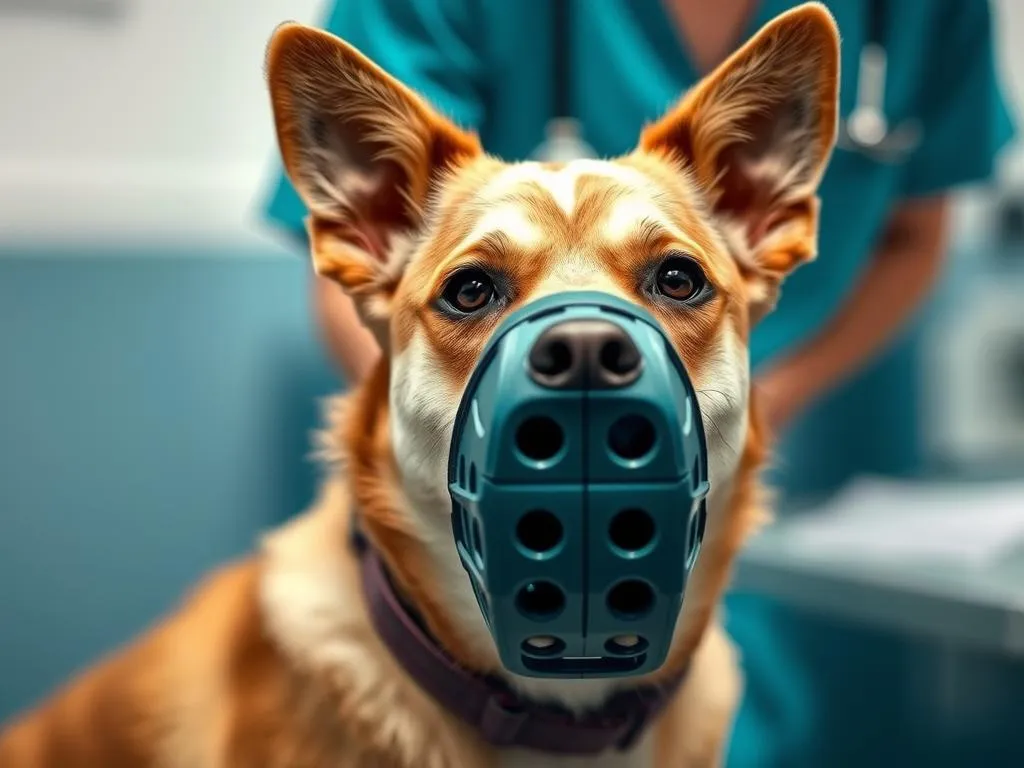
Introduction
When it comes to our beloved pets, their health and safety are paramount. However, for some dogs, visiting the vet can be a stressful experience. Why do some dogs need to be muzzled at the vet? The answer is multifaceted, encompassing behavioral, medical, and safety considerations. Understanding the reasons behind the use of muzzles not only promotes responsible pet ownership but also ensures a safer environment for everyone involved.
This article aims to inform pet owners about the circumstances that may require a muzzle during vet visits. By shedding light on this important topic, we hope to alleviate misconceptions about muzzling and advocate for the well-being of both pets and veterinary staff.
Understanding Muzzles
What is a Muzzle?
A muzzle is a device that fits over a dog’s snout, preventing them from biting or barking. There are various types of muzzles, with the most common being basket muzzles and nylon muzzles.
- Basket Muzzles: Made of plastic, metal, or leather, these muzzles allow dogs to open their mouths slightly, enabling them to breathe comfortably, drink water, and pant.
- Nylon Muzzles: Typically made from durable fabric, nylon muzzles are designed to limit a dog’s ability to open their mouth but offer little ventilation.
Purpose of Muzzles
Muzzles serve several important purposes in veterinary settings:
- Preventing Biting and Aggression: Muzzles are crucial for preventing biting incidents, especially during stressful situations where a dog may feel threatened or in pain.
- Reducing Stress: For some dogs, wearing a muzzle can help reduce anxiety by providing a sense of security to both the dog and the vet staff.
Reasons for Muzzling at the Vet
Behavior Issues
Understanding behavioral triggers is essential when considering why do some dogs need to be muzzled at the vet. Many dogs exhibit aggressive behavior due to fear, pain, or anxiety.
- Fear: Dogs that have had negative experiences at the vet may react defensively. Muzzling can help manage these reactions while allowing the vet to perform examinations safely.
- Pain: A dog in pain may lash out unexpectedly. Muzzling protects both the dog and the vet from potential harm.
Medical Reasons
There are scenarios where a dog may need to be muzzled due to medical reasons. For example, if a dog is injured or in distress, they may react aggressively out of fear or discomfort.
- Protecting Vet Staff: A muzzled dog allows veterinary professionals to conduct necessary examinations or procedures without the risk of getting bitten.
Safety for Other Pets
A veterinary clinic often houses multiple pets, making safety a primary concern. Muzzling helps ensure a safe environment for all animals present.
- Preventing Altercations: In multi-pet clinics, muzzling helps prevent potential altercations between dogs, providing a calmer atmosphere for everyone.
When is Muzzling Necessary?
Types of Vet Visits
Not all vet visits necessitate a muzzle. The need for muzzling can vary depending on the type of visit.
- Routine Check-Ups: Generally, most dogs can handle routine check-ups without a muzzle unless they have a history of aggression or anxiety.
- Emergency Situations: In emergencies, when a dog may be in pain or frightened, muzzling becomes more critical to protect the staff and ensure safety.
Specific Scenarios Requiring a Muzzle
Certain situations warrant the use of a muzzle more than others.
- Aggressive Breeds: Dogs belonging to breeds often labeled as aggressive may be muzzled as a precautionary measure.
- History of Trauma: Dogs that have previously experienced trauma at the vet may require muzzling due to heightened anxiety and potential for aggression.
Benefits of Muzzling
Enhanced Safety
One of the most significant benefits of muzzling is the enhanced safety it provides.
- Protection for Vet Staff: Muzzles protect veterinary staff from potential bites, creating a safer environment during examinations or procedures.
Stress Reduction
Interestingly, muzzling can also help reduce anxiety in dogs during vet visits.
- Calming Effect: A muzzle can create a sense of security, allowing the dog to feel more at ease amidst the stress of a veterinary visit.
Facilitating Treatment
Muzzling enables vets to perform necessary treatments without the fear of being bitten.
- Efficient Care: With the dog secured, the vet can focus on delivering essential care, ensuring the health of the pet remains the top priority.
Choosing the Right Muzzle
Types of Muzzles and Their Uses
When it comes to selecting a muzzle, understanding different types is crucial.
- Basket Muzzles: Best for longer visits, allowing dogs to pant and drink.
- Nylon Muzzles: Suitable for short-term use, especially in emergencies.
How to Properly Fit a Muzzle
Fitting a muzzle correctly is essential to ensure comfort and effectiveness. Here’s a step-by-step guide:
- Measure Your Dog’s Snout: Use a tape measure to determine the length and circumference of your dog’s snout.
- Choose the Right Size: Select a muzzle that fits snugly but doesn’t constrict.
- Adjust the Straps: Ensure that the muzzle is secure but allow for some movement.
Training Your Dog to Accept a Muzzle
Training your dog to accept a muzzle can significantly ease the process. Here are some tips:
- Introduce Gradually: Start by letting your dog sniff the muzzle before attempting to put it on.
- Use Positive Reinforcement: Reward your dog with treats for calm behavior when wearing the muzzle.
- Practice Regularly: Incorporate short sessions with the muzzle at home to build familiarity.
Common Misconceptions About Muzzling
Muzzles Are for Bad Dogs
One of the most pervasive misconceptions is that muzzles are only for “bad” dogs.
- Understanding Behavior: Many dogs may need muzzles due to fear or anxiety rather than aggression.
Muzzles Are Cruel
Another common belief is that muzzling is a cruel practice.
- Humane Use: When used correctly, muzzles can provide a sense of safety for both the dog and those around them.
Muzzles Mean the Dog is Dangerous
Many people assume that a muzzled dog is inherently aggressive.
- Precautionary Measure: Muzzling is often a precautionary measure, not an indication of a dog’s temperament.
Alternatives to Muzzling
Behavioral Training
Investing in behavioral training can significantly reduce the need for muzzling.
- Positive Behavior Reinforcement: Teaching commands and rewarding good behavior can help alleviate aggression and anxiety.
Calming Products
In addition to training, there are calming products available that can assist in managing anxiety during vet visits.
- Calming Aids: Consider using pheromone sprays, calming treats, or anxiety wraps to help your dog feel more relaxed.
Conclusion
Understanding why do some dogs need to be muzzled at the vet is essential for fostering a safe and positive environment for both pets and veterinary staff. Muzzling is not an indication of a dog’s temperament but a responsible precaution to ensure safety during potentially stressful situations. By educating ourselves and being proactive in our dogs’ health and well-being, we can help cultivate a more harmonious relationship between our pets and their veterinary care providers.
Taking the time to learn about muzzling, training alternatives, and calming products can make a significant difference in how our dogs experience vet visits. As responsible pet owners, it’s our duty to advocate for our furry friends while ensuring their safety and well-being at all times.








